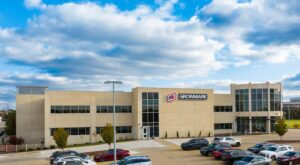By: Chris Wilhem
The construction industry has never been known as early adapters, but in recent years with the explosion of the IOT and cloud, the industry has made a quantum leap in technology.
The shift to move technology to the forefront of the construction process is primarily due to the changes in our social climate. We live in a world of instant gratification, with information readily available and where nothing is out of reach. The demands from society give people a reasonable expectation of connectivity and security when entering a building.
The demands on the construction industry are much the same – build faster, less expensive and with more amenities keeping connectivity and security in mind.
There is no question, when you enter a building you expect the same connectivity that you are accustomed to at home. For example, when you walk into your office, you expect to have the ability to not only connect with co-workers or clients but to also connect with your family, friends, etc.
We forget that we weren’t always able to login to our home security cameras during the day, get alerts when your Amazon package arrives or get real-time footage from your child’s daycare. Technology has evolved to where the phone in your hand is not only controlling home but is also how you interact with commercial buildings being built today.
Now it is a given that your phone will always keep you in contact. The expectation has evolved to having your phone turn on the lights in your office, control the HVAC, turn off alarms, etc., making everyday tasks seamless.
Technology has to be a part of the design process; to make this experience seamless.
Our need for constant connectivity also makes us hyper-aware of each tragedy that hits the headlines, creating an expectation for safety and pushing security to the forefront of building design. The design becomes a matter of how do you keep occupants safe, plan for an event, without invading people’s privacy, adding operational cost and potentially mitigating liability.
The advancements in technology such as video surveillance and access control have made it possible. The advancements in video surveillance technology using artificial intelligence deliver an extra layer of protection. These cameras can be programmed to send alerts of a potential threat, identify people that may cause harm, analyze situations and even predict what is going to happen before it happens.
By implementing this technology during the design process, the system can start analyzing and optimizing the viewing angles of cameras in the environment before the building has occupants. Access control technology has also started becoming more prevalent in the construction process due to the how people are accessing buildings. As buildings continue to become smarter, keys and locks are transitioning to wireless allowing card access to be installed on any door.
In the past, it was the perceived cost that kept technology from the forefront. Now it is seen as cost-effective with countless benefits. Today it is possible that all the technologies can work in harmony: lighting is set to optimize for security, there are no blind spots due to landscaping, camera placements are designed to cover the entire parking lot, etc. Manufacturers and contractors are collaborating on the design, making integration unified.
As owners become aware of the cost savings and efficiencies of technology, their involvement and needs are becoming more integrated during the design process. The art of building is taking all of these considerations into thought at the beginning. If you could put it all together up front, wouldn’t you?
Click here to learn more about Construction services



